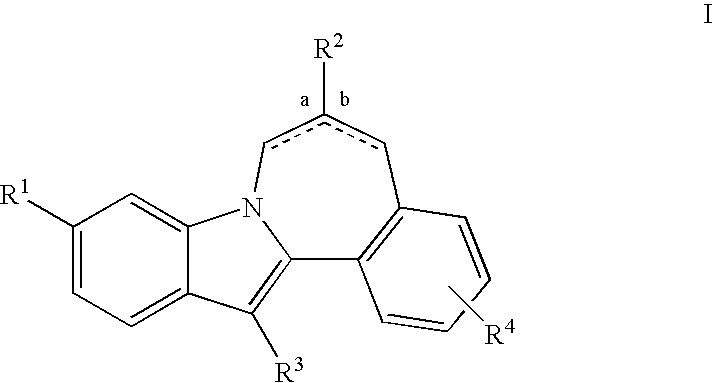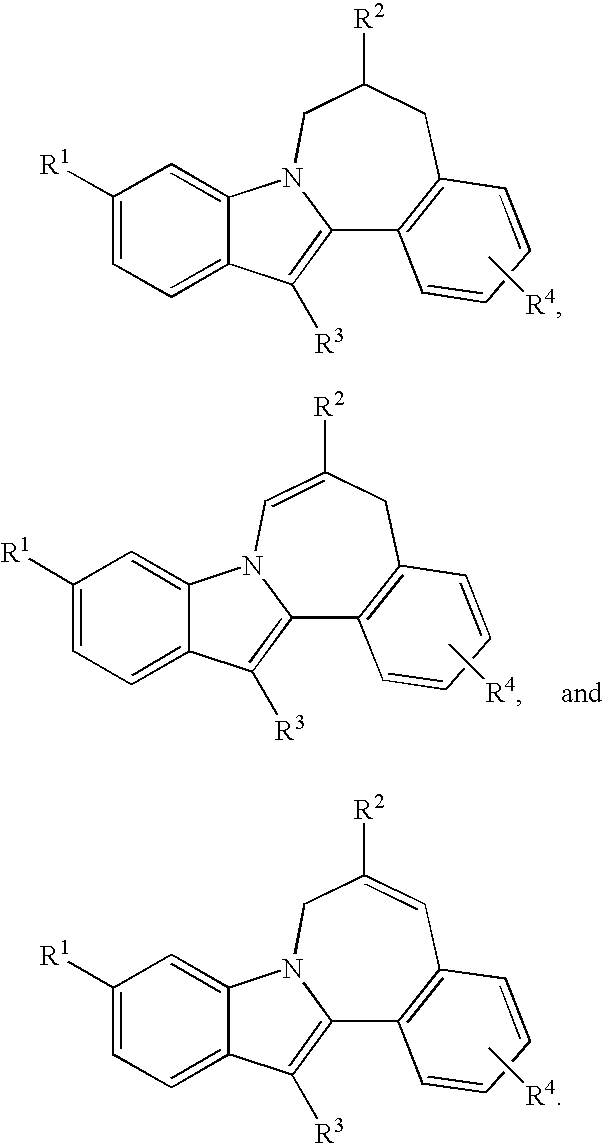HCV NS5B inhibitors
a technology of hcv and inhibitors, applied in the direction of heterocyclic compound active ingredients, biocide, drug compositions, etc., can solve the problem that a large percentage of patients do not have a sustained reduction in viral load
- Summary
- Abstract
- Description
- Claims
- Application Information
AI Technical Summary
Benefits of technology
Problems solved by technology
Method used
Image
Examples
example 1
[0120]
[0121]13-cyclohexyl-6-(1H-tetrazol-5-yl)-7H-indolo[2,1-a][2]benzazepine-10-carboxylic acid, methyl ester. To a solution of 7H-indolo[2,1-a][2]benzazepine-10-carboxylic acid, 6-cyano-13-cyclohexyl-, methyl ester (200 mg, 0.504 mmol) in toluene (2.0 mL) was added tributyltin azide (502 mg, 1.51 mmol). The resulting solution was stirred in a sealed tube in a microwave at 150° C. for 30 min. 1M HCl (15 mL) was added and the aqueous layer was extracted with CHCl3 (2×30 mL). The organic phase was dried over Na2SO4, filtered, and concentrated under reduced pressure. Silica gel chromatography (9:1 EtOAc:methanol) of the concentrate afforded the title compound (191 mg, 86%) as a yellow oil. MS m / z 440 (MH+), 1H NMR (300 MHz, CD3OD) δ ppm 1.18-1.69 (m, 5H), 1.79 (m, 2H), 1.86-2.15 (m, 3H), 2.87 (m, 1 H), 3.94 (s, 3H), 4.52 (broad m, 1 H), 5.97 (broad m, 1 H), 7.49-7.54 (m, 3 H), 7.62 (d, J=7.6 Hz, 1 H), 7.68 (d, J=8.4 Hz, 1 H), 7.75 (s, 1 H), 7.86 (d, J=8.4 Hz, 1 H), 8.38 (s, 1 H).
examples 2 and 3
[0122]
[0123]13-cyclohexyl-6-(2-ethyl-2H-tetrazol-5-yl)-5H-indolo[2,1-a][2]benzazepine-10-carboxylic acid and 13-cyclohexyl-6-(2-ethyl-2H-tetrazol-5-yl)-7H-indolo[2,1-a][2]benzazepine-10-carboxylic acid. To a solution of 7H-indolo[2,1-a][2]benzazepine-10-carboxylic acid, 13-cyclohexyl-6-(1H-tetrazol-5-yl)-, methyl ester (40 mg, 0.09 mmol) in DMF (1.0 mL) and cesium carbonate (60 mg, 0.18 mmol) was added iodoethane (28 mg, 0.18 mmol). The resulting mixture was heated at 60° C. for 18 hr. Water (1 mL) was added and the mixture was heated at 60° C. for an additional 8 hr. 1M HCl (15 mL) was added and the aqueous layer was extracted with CHCl3 (2×30 mL). The organic phase was dried over Na2SO4, filtered, and concentrated under reduced pressure. This oil was purified by reverse-phase prep HPLC to afford the title compounds. 7H-indolo[2,1-a][2]benzazepine-10-carboxylic acid, 13-cyclohexyl-6-(2-ethyl-2H-tetrazol-5-yl)-: 20 mg, 49% yield. MS m / z 454 (MH+), 1H NMR (300 MHz, CD3OD) δ ppm 1.17-...
example 4
[0124]
[0125]13-cyclohexyl-N-[(dimethylamino)sulfonyl]-6-[2-ethyl) -2H-tetrazol-5-yl]-7H-indolo[2,1-a][2]benzazepine-10-carboxamide. To a solution of 7H-indolo[2,1-a][2]benzazepine-10-carboxylic acid, 13-cyclohexyl-6-(2-ethyl-2H-tetrazol-5-yl)-(87 mg, 0.19 mmol) in CH2Cl2 (1.0 mL) was added 2M oxalyl chloride (0.48 mL, 0.96 mmol). This solution was stirred at 22° C. for 3 hr and then concentrated under reduced pressure. BEMP (0.22 mL, 0.76 mmol), CH2Cl2 (1.0 mL) and N,N-dimethylsulfamide (120 mg, 0.96 mmol) was added to the resulting oil. The resulting mixture was stirred for 6 hr at 22° C. 1M HCl (15 mL) was added and the aqueous layer was extracted with CHCl3 (2×30 mL). The organic phase was dried over Na2SO4, filtered, and concentrated under reduced pressure. This oil was purified by reverse-phase prep HPLC to afford the title compound (56 mg, 52%) as a yellow paste. MS m / z 561 (MH+), 1H NMR (300 MHz, CD3OD) δ ppm 1.16-1.64 (m, 5H), 1.68 (t, 3 H), 1.80 (m, 2H), 1.86-2.16 (m, 3H), ...
PUM
| Property | Measurement | Unit |
|---|---|---|
| optical density | aaaaa | aaaaa |
| concentration | aaaaa | aaaaa |
| pH | aaaaa | aaaaa |
Abstract
Description
Claims
Application Information
 Login to View More
Login to View More - R&D
- Intellectual Property
- Life Sciences
- Materials
- Tech Scout
- Unparalleled Data Quality
- Higher Quality Content
- 60% Fewer Hallucinations
Browse by: Latest US Patents, China's latest patents, Technical Efficacy Thesaurus, Application Domain, Technology Topic, Popular Technical Reports.
© 2025 PatSnap. All rights reserved.Legal|Privacy policy|Modern Slavery Act Transparency Statement|Sitemap|About US| Contact US: help@patsnap.com



